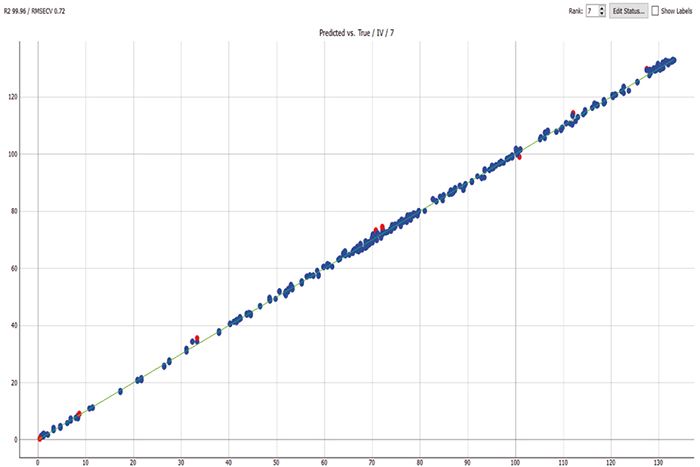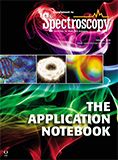Analysis of Edible Oils by FT-NIR Spectroscopy
Application Notebook
Fats and oils are recognized as essential nutrients in human diets and are presented in varying amounts in many foods. They not only provide the human body with a concentrated source of energy, but also supply essential fatty acids that are precursors for important hormones. The quality of edible fats and oils are assessed through parameters such as: iodine value (IV), trans content, peroxide value (PV), anisidine value (AV), saponification number (SN), free fatty acids (FFA), and solid fat content (SFC). The traditional chemical and chromatographic methods used to analyze edible fats and oils are labor intensive, require the use of solvents and reagents, and are extremely time consuming.
FT-NIR spectroscopic analysis of fats and oils is fast, requires no sample preparation, and can analyze multiple parameters with a single measurement. An infrared spectrum of an oil contains a wealth of information that can be used to determine important factors. For example, the OH stretching region can indicate the presence of moisture or hydroperoxides, the latter commonly measured by the chemical PV test. The intensities of the bands in the CH region and of the ester linkage absorption are related to the average molecular weight of oil, commonly evaluated by SN determinations. The COOH absorption is indicative of lipolysis or free fatty acid (FFA) content of an oil. The presence of spectral features related to aldehydes and ketones, as well as conjugated dienes, suggests accumulation of secondary oxidation products commonly measured by the thiobarbituric acid (TBA) test or the AV test. The isolated trans band provides a direct measure of isolated trans isomers, and the combination of CH cis and CH trans absorptions provides a measure of total unsaturation or IV. The complete spectrum of a refined, melted fat characterizes its overall triglyceride composition, which in turn can be related to its SFC and also provides information about the relative amounts of saturated, monounsaturated, and polyunsaturated fatty acids in a fat or oil.
Near-infrared (NIR) spectroscopy contains combination bands and overtones of fundamental vibrations in the infrared region and provides several practical advantages over infrared spectroscopy. For example, while infrared measurements require direct contact with the sample, NIR can measure oil samples in disposable glass vials, significantly reducing the risk of cross contamination. What's more, NIR spectra can be measured online with a fiber optic probe.
NIR spectroscopy has been recognized by AOCS (American Oil Chemist Association) and AOCS method Cd1e-01 uses FT-NIR to measure Iodine Value (IV). In addition, it proves to be a useful tool in the detection of oil adulteration.
Experimental
Various types of fat and oil samples were measured using a QuasIR™ 4000 FT-NIR spectrometer with heatable sample compartment. Oil samples were measured in an 8 mm glass vial at 75 °C following AOCS method Cd1e-01. Three spectra per sample were collected using 8 cm-1 resolution.
Quantitative Analysis
Spectral Sage™ PLS Quantitative Analysis software was used to develop partial least square calibrations for various parameters.

Figure 1: FT-NIR spectra of oils in the range of 4500–9000 cm-1.
NIR spectra of four different types of oils with varying degrees of unsaturation are shown in Figure 1. Partial least square calibrations were developed for, but not limited to, the following parameters:
- Iodine Value (IV)
- Anisidine Value (AV)
- Linolenic acids (C18:3)
- mono-unsaturation (MUFA)
- poly-unsaturated (PUFA)
- Saturated (SAFA)

Figure 2: Cross-validation of IV calibration.
The cross-validation results of iodine value (IV) and linolenic acids calibrations are displayed in Figure 2 and Figure 3, respectively.

Figure 3: Cross-validation result of C18:3.
Conclusion
Galaxy Scientific QuasIR FT-NIR brings fast, accurate NIR analysis closer to the point-of-need, by combining portability with superior spectroscopic performance. These next generation field portable platforms which combine next generation optics with advanced software algorithms providing breakthrough solutions to the most challenging point-of-need applications. Samples can then be analyzed in the field, rather than be taken off site to separate laboratories.
Quantum Analytics is an authorized distributor of the QuasIR FT-NIR instrument, as well as other instruments for food analysis. Contact us today to discuss your application needs.

Quantum Analytics
3400 East Third Avenue, Foster City, CA 94404
tel. (650) 312-0900
website: www.LQA.com

New Study Reveals Insights into Phenol’s Behavior in Ice
April 16th 2025A new study published in Spectrochimica Acta Part A by Dominik Heger and colleagues at Masaryk University reveals that phenol's photophysical properties change significantly when frozen, potentially enabling its breakdown by sunlight in icy environments.
Advanced Raman Spectroscopy Method Boosts Precision in Drug Component Detection
April 7th 2025Researchers in China have developed a rapid, non-destructive Raman spectroscopy method that accurately detects active components in complex drug formulations by combining advanced algorithms to eliminate noise and fluorescence interference.